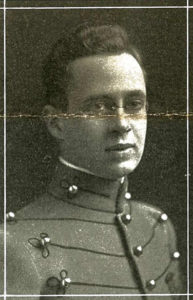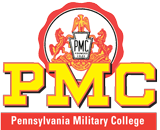 Less than a year after James Calvin Hobart Jr. graduated from PMC in 1916, the United States entered World War I, and he was eager to get into the fight.
Less than a year after James Calvin Hobart Jr. graduated from PMC in 1916, the United States entered World War I, and he was eager to get into the fight.
Rejected a dozen times by various branches of the American military because of poor eyesight, he left home in Cincinnati in 1917 for France. There, on July 9, he joined the American Field Service as one of a growing number of American volunteers assigned to the French Army’s Réserve Mallet transportation unit. Praised by the French as “America’s first belligerents,” the 800-member unit convoyed ammo and materiel from the railheads on the Soissons-Fismes road to the Chemin des Dames on the Western front.
Hobart was placed in Transport Materiel Unit 397 Groupe Hémart. On a typical sortie, he ferried 10,200 pounds of 75 mm artillery rounds through shell-pocked terrain in his five-ton Pierce Arrow truck as French and German pilots dueled in the skies above.
The work was dangerous, and Hobart saw plenty of action.
 “I watched what first appeared to be a column of black smoke,” he wrote in a letter home. “I caught one of these columns at its birth. It was a huge fountain of earth which rose, oh, I’d say about forty feet in the air, spread out and came back to earth. I’d counted about forty or fifty of these ‘Jack Johnsons.’ I closed my eyes and listened to the rifle fire; I’d lie on my back and see the Shrapnel bursting around a dozen French planes.”
“I watched what first appeared to be a column of black smoke,” he wrote in a letter home. “I caught one of these columns at its birth. It was a huge fountain of earth which rose, oh, I’d say about forty feet in the air, spread out and came back to earth. I’d counted about forty or fifty of these ‘Jack Johnsons.’ I closed my eyes and listened to the rifle fire; I’d lie on my back and see the Shrapnel bursting around a dozen French planes.”
The 23-year-old attempted to make light of the dangers. “I’m just as happy and safe as if I were at home,” he wrote his family in mid-August 1917. But in the next breath, he added: “God’s will be done. Remember that’s what you pray for and hope for. So, Mother, if anything happens, please take it that way. I intend to come back and would be darned sorry not to, but if He decides otherwise, let’s be glad it’s so.”
That month, Hobart was decorated for his service by the French government in a ceremony that included “one French general, on colonel, one major, one captain and a general of the British Army.”
“We, about thirteen of us, were called to attention…decorated and kissed twice, once on each cheek,” he wrote home. “At this point, a German plane was sighted and we all scuttled off the open field and made for a wood nearby.” Records of the century-old ceremony are elusive and it is not clear what medal Hobart was awarded. AFS drivers received three types of French Army decorations, the Légion d’honneur, the Médaille militaire, and the Croix de Guerre.
After he had served three months with Réserve Mallet, the U.S. Army assumed control of the AFS and Hobart (still disqualified from the military by what he called “these dishpans I have for specs”) joined the American Red Cross as an ambulance driver. “If PMC taught me anything,” he wrote a friend, “it taught me to perform a duty whether pleasant or not. I leave for Italy, December 3, 1917.”
Later, he wrote: “I am driving Ambulance 87. That was my old number at PMC. Funny how that was assigned to me!”
Hobart died in Albuquerque, N.M, at age 76 after serving as an administrative officer in the Atomic Energy Commission

